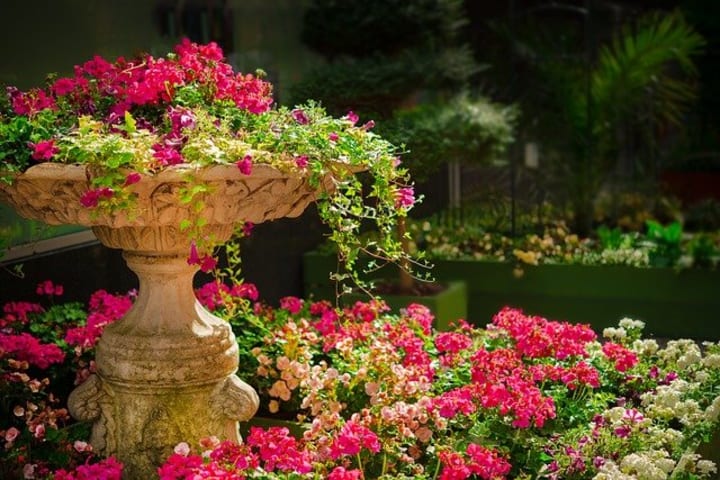34 ways to simply and easily take care of your garden
We are constantly thinking about how to make gardening easier. It is important to lay the garden in such a way as to simplify the main work.

I will try to formulate all the accumulated experience on the points, which boils down to minimizing the number of complex professional work in the garden:
1. Plantings with simple forming prunings (hedges, balls, cubes) are a good architectural element and are not difficult to reproduce. Any unskilled specialist will be able to learn how to cut such simple shapes. If you do not want to complicate the gardener's life, do not plan high hedges: you will need additional equipment and time to maintain them.
2.For the formation of hedges and other shorn forms, it is better to take not strong-growing plants , but relatively slow-growing, thuja.
3. When laying flower beds, use a structure of groups of shrubs of various shapes, leaf colors and blooms. In the leafless period, the shrubs retain the shape of flower beds and grow longer in one place without transplants.
4. Multi-stemmed forms of trees allow you to create a whole mini-forest in a private garden. Plus, multi-barrel forms are not as high as single-barrel ones.

5.Flower beds should be laid from "real perennials" that are long (7-10 years) they grow in one place and do not require frequent division or replacement. And the easier it is to care for them (cut them off once in the spring and fertilize them), the better. Cereals are ideal in this regard. It is clear that it is difficult to make flower beds entirely from such simple perennials, but their number in planting should prevail.
6. Do not lay hedges of prickly shrubs in the flower garden: it will be difficult to care for, pruned prickly branches will come across all the time. It is better to form a free-standing fence from such rocks, when pruning which you can easily collect all the branches with a rake.
7. Leave a free space next to prickly shrubs, so as not to be injured by the thorns of the plant when cutting.
8. Design such flower beds so that in the spring it is enough to walk with a lawn mower or a trimmer (it is even more convenient to do this with a lawn mower without a bag for collecting grass). It is better to leave the entire cut in the flower garden (this is both mulch and fertilizer). Flower beds grow quickly enough and hide all the crushed stems behind the leaves.

9. Mulching material is required. Do not leave the soil bare, cover it with bark, mown lawn, crushed stems, and other loose materials. Bare soil is a loss of moisture, weeds, erosion, compaction.
10. It is better to plant plants in large arrays, this makes it easier to care. It is easier to trim a curb or a wide landing of spirea with a trimmer than to cut each bush separately. For a layman, plants planted in large arrays are easier to care for against the background of monotonous plantings, the weed is clearly visible. If the plantings are complex, with a large variety of species, then it is difficult for a layman to understand whether it is a weed in front of him or so it is intended.
11. If the shape of the plants allows you to plant with a high density, then we plant more densely to speed up the closing and reduce the weeding time.
12. The lawn takes a lot of time with mowing. I made a list of when to comb, when to fertilize, how to weed out weeds. Nothing complicated. But we must always remember that the lawn in the garden has its own functions. You do not need to try to fill all the available space with them: along the fence behind the bushes, under the trees, and so on.
13. The lawn should be of a simple shape so that it can be mowed according to a simple scheme, without being distracted by lifting fallen plants from flower beds, without cutting the edge and the lawn around the bushes separately with a trimmer. No plants in the lawn, a maximum of one tree, and even it should be planted taking into account the passage of the lawn mower (with free space around).

14. The edge between the flower garden and the lawn is mandatory, so that the lawn mower passes in one step without touching the planting. Ideally, this is a curb made of stone, wood.
15. Lamps should not be located on the lawn: this makes it difficult to mow it. Place them either in plantings or on hard surfaces.
16.Now there are robots-lawn mowers. Therefore, it is necessary to provide for the layout of the lawn and the place for charging the robot so that it can go to work itself without the help of a person and freely deal with the lawn. With a well-planned lawn, the presence of automatic irrigation and such a robot, you can forget about regular care. You will only need weed treatments and fertilizer.
17. No narrow strips of lawn between the plantings and the hard surface! It looks beautiful only in photos with a freshly laid lawn. Make the planting wider, duplicate the plants with one or two more rows.
18. If you need a "lawn" for the idea, but you do not want to expand the existing volume (for example, behind a fence) or the place is inconvenient for mowing (slope), then carpet planting of a low creeping coniferous plant (for example, juniper or mountain pine varieties) or low-growing deciduous shrubs is suitable.

19. It is better not to break the lawn in front of the house (if the front garden is small). It is inconvenient to carry a lawn mower from the backyard every time. And the lawn in the front garden should be as well-groomed as possible. Fill the places for planting with the most stable forms that preserve their decorative state for as long as possible.
20. When designing, remember that there are no few hard surfaces. For each square meter of plantings, care is required many times more than for a hard surface (paving, flooring, gravel). 34 ways to simply and easily take care of your garden.
21. Do not skimp on the width of the tracks. The plants grow and "get out" on the paths. If you want to save on material, it is better to put an expensive solid in front of the house, and make the paths in the garden itself from loose, cheaper materials. Leave passages of at least a meter: this is convenient for both care and ventilation of crops, and you can drive a wheelbarrow even in the season itself.
22. In certain areas of the site where you want to take care of the least (a narrow passage between the house and the fence, parking, technical places), it is better to plant dense homogeneous bush planting with a thick layer of mulch, including crushed stone (for reliability, you can put geotextile under the crushed stone).
23. The easiest way to clean paved paths is with a pressure washer (it removes both moss and weeds). Quickly and efficiently, and you do not need to use chemicals – everything is simply washed off in the planting.

24. Hide existing "household objects" (septic tank hatches, wells and other communications) in the curtains of flower beds. There they are less noticeable and do not require special coloring.
25. Use only disease-resistant plant varieties. If the species forms often get sick, use specially bred varieties to solve this problem. Also, plant strong plants that are resistant to wind and rain. It is better to abandon capricious cultures altogether.
26. If you want to use roses, it is better to plant all kinds of groundcover roses. They winter well, get sick a little and do not require complex care, including pruning. We recommend removing all branches in the spring, leaving three buds from the ground for well-wintered shoots. 34 ways to simply and easily take care of your garden.
27.In the first few years, regular frequent weeding will be needed until the plants close, become stronger and begin to suppress weeds themselves. The main thing is not to miss these first years, otherwise the weeds will clog the flower beds and it will be almost impossible to clean them – you will have to replant again.
28. It is better to put the work on the shoulders of professionals. Let it be an annual one-time spring care or two trips a year (spring-autumn). At least one trip every two years, so that a professional does complex work and outlines a course of permanent unskilled work.

29. To take care of the garden, it is better for the owner to buy a good reliable tool. An automatic tool (for example, for cutting hedges) simplifies and speeds up the work.
30. Automatic irrigation for the entire plot. You can configure different zones, depending on your needs. Regular watering is important for the lawn and garden. Regular watering is important for the lawn and garden. In flower beds, it is better to use drip irrigation.
31. It is important to treat plants after planting from diseases and pests (it is better to do this right on the day of planting). Immediately after landscaping one plot, all beetles and other pests moved to it from neglected and untreated neighboring plots in search of newly planted plants. Nurseries process plants, but at the time of planting at your facility, it is difficult to say which nursery and when it was processed. Therefore, it is best to process it.
32. Watch the orientation of the branches (whether they will interfere with the passage, whether they will not rest against a fence or a power line in the future), so that later you do not have to radically cut and spoil the shape of the crown.
33. For the garden, you need to purchase a stem chopper. With age, there will be more and more waste left after pruning, so it is more logical to recycle everything and use it as mulch and natural fertilizer.

34. In a ready-made mature garden, try to avoid unnecessary digging, so as not to provoke a violent growth of weeds. Remove weeds, add organic matter.
When performing these simple methods, you will significantly reduce the amount of hassl.
© 2021 Elena Petrova
About the Creator
Elena Sunshine Magazine
Fresh ideas every day.






Comments
There are no comments for this story
Be the first to respond and start the conversation.